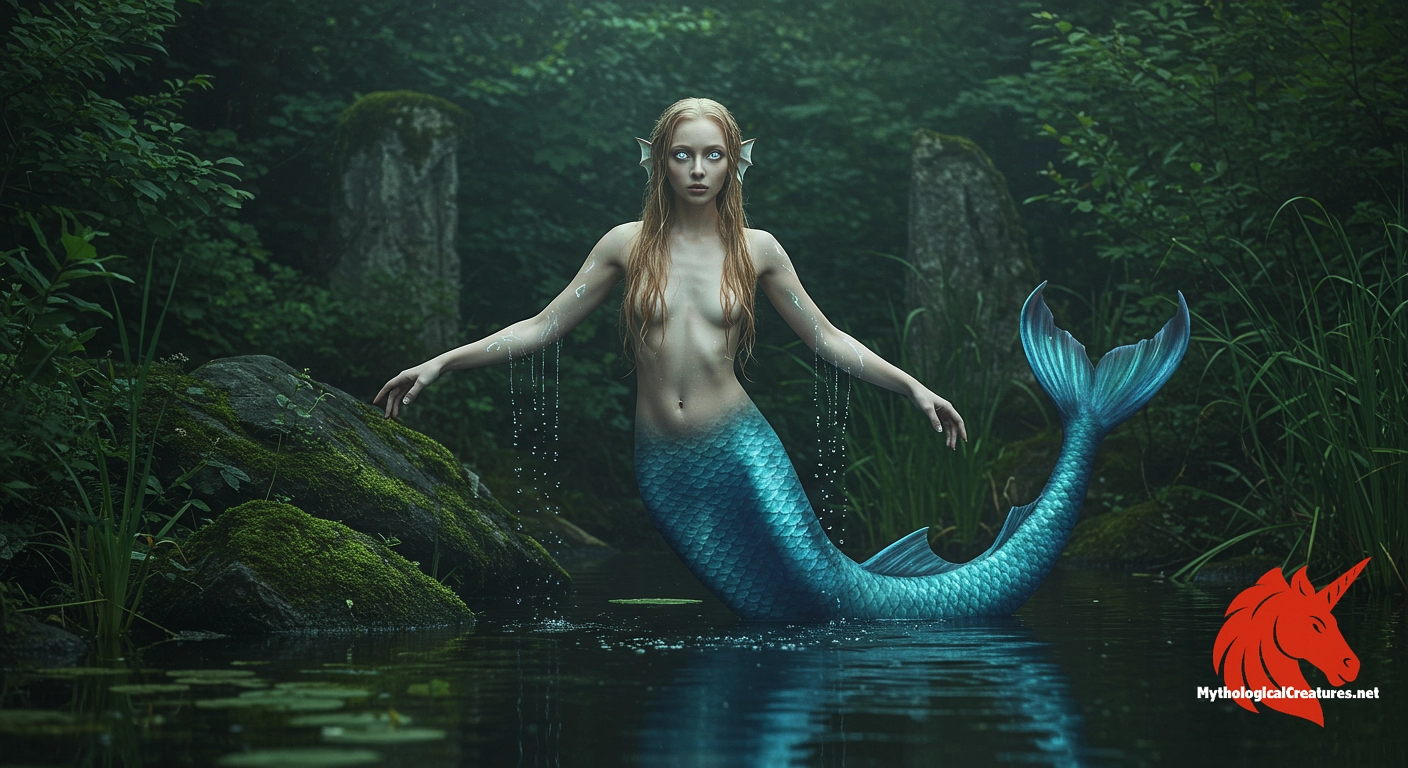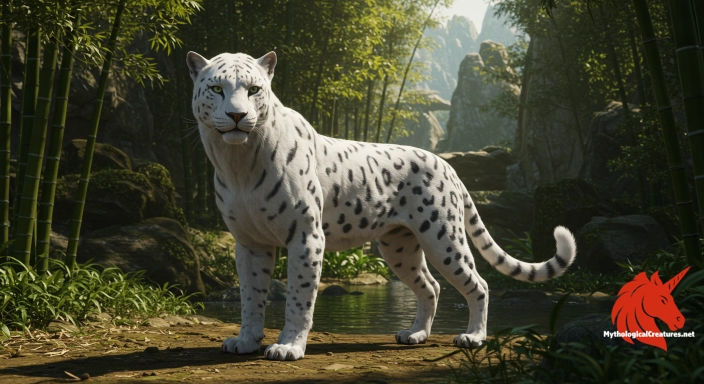Rusalka: The Rusalka is a female water spirit from Slavic folklore, often depicted with a mermaid-like appearance and an enchanting yet perilous allure.

Rusalka
Rusalka - Embodies the dual nature of water as both life-giving and deadly, reflecting themes of beauty, sorrow, and retribution in Slavic mythology.
Origins & First Encounters
The Rusalka emerges from Slavic folklore as a captivating figure whose origins are deeply rooted in ancient pagan traditions. She is often depicted as a water spirit with a dual nature, embodying both alluring beauty and an element of peril that mirrors the unpredictable forces of water. Historical narratives suggest that her early role may have been as a benevolent guardian of lakes and rivers, later transforming into a more ominous and cautionary character. Over time, the figure evolved amid shifting cultural attitudes, reflecting both the mystical reverence and the deep-seated ambivalence that communities felt towards water. Her earliest mentions trace back to oral traditions and medieval folklore, which imbued her with layers of symbolic meaning. The Rusalka has long been intertwined with themes of love, loss, and the capricious moods of nature. Often emerging when water meets land, she serves as a reminder of nature’s beauty and its inherent dangers. In modern times, she has been reinterpreted by artists and writers, ensuring her legacy endures as a powerful icon of both nature and myth.
Source Texts & Tale Variants
Ancient manuscripts and oral traditions form the cornerstone of our understanding of the Rusalka. Folklore collected over centuries in Eastern Europe reveals a tapestry of narratives that portray her in varying lights, from a nurturing presence to a vengeful spirit. Texts and chronicled legends from the 18th and 19th centuries offer detailed accounts, preserving local superstitions and rituals associated with her. These primary sources often highlight the regional richness of her character, with different communities emphasising distinct traits. Many of these narratives were transmitted orally before being recorded, ensuring that her story adapted to the cultural and historical context of each locale. In some versions, she is depicted as a tragic figure caught between the realms of life and death, while in others she is a mischievous tempter. The fragmented nature of these sources has only added to the mystery surrounding her character, inviting continuous reinterpretation. Ultimately, the diverse strands of oral and written accounts contribute to a multifaceted portrayal that has intrigued and captivated audiences for generations.
Form & Powers
The Rusalka is often envisioned as an exquisitely beautiful maiden whose appearance is both enchanting and otherworldly. Her long, flowing hair is frequently described as shimmering like the surface of a serene lake at dawn, cascading in a manner that seems to echo the gentle movement of water. Her eyes, deep and reflective, mirror the varying moods of the natural world and seem to hold untold stories of joy and sorrow. In some tales, she is portrayed with a subtle luminescence, a ghostly glow that blurs the lines between humanity and the supernatural. Delicate, almost ethereal features and a pale complexion contribute to her mysterious allure, inviting admiration as well as caution. Certain depictions even suggest that she possesses hints of aquatic anatomy, such as webbed fingers or a faint, fish-like tail, lending her a mystical connection to the water. Variations in her size and stature are noted across legends, with some accounts describing her as larger than life to evoke a sense of divine majesty. Adorned with natural accoutrements like crowns of river reeds or garments woven from water plants, her appearance is a mirror of the enchanting yet unpredictable element she represents.
Regional Faces
The narrative of the Rusalka is richly coloured by regional variations that have shaped her character to reflect diverse local traditions. In northern Russia, she is known by titles such as Vodyanitsa, Kupalka, Shutovka, and Loskotukha, each name capturing a different facet of her persona. These regional adaptations portray her either as a beguiling water maiden with a playful twist or as a forewarning of nature’s more treacherous aspects. In Ukraine, the figure is celebrated under the name Mavka, where tales often present her as a more benign, even melancholic, presence connected to the natural landscape. Polish folklore too offers its own unique interpretations, sometimes aligning her with river deities whose beauty masks the lurking dangers of water. This spectrum of regional renditions reveals how local customs and environmental factors contribute to the evolution of her myth. The variety in her depictions reflects a broader cultural engagement with nature—a blend of admiration, fear, and respect within these communities. Each variant preserves the central motif of water as a life-giving yet hazardous force, ensuring that despite regional differences, the core symbolism of the Rusalka remains intact.
Cultural Parallels
The Rusalka shares many thematic and symbolic parallels with other water spirits found throughout European mythologies. Similarities with the French Melusine are particularly striking, as both figures embody the enchanting yet capricious nature of water and often serve as cautionary symbols. The Germanic Nixie, too, echoes these attributes, presenting the archetype of the elusive, sometimes treacherous, water-bound seductress. These comparative images illustrate a broader cultural motif where water entities captivate with their beauty while also harbouring potential for destruction. Such water spirits across various traditions often serve to illustrate the duality of nature, a recurring theme that underscores both its nurturing and perilous facets. The shared traits across these figures suggest that numerous cultures have independently developed a profound respect for water, imbuing it with both creative and destructive powers. Yet, the Rusalka stands apart through the unique Slavic lens that frames her as both a remnant of ancient pagan reverence and a modern emblem of nature’s mystery. In cross-cultural analysis, the common narrative threads serve to highlight humanity’s enduring fascination with the natural world and its eternal capacity to inspire myth and metaphor.
Legacy & Modern Evolution
The historical evolution of the Rusalka reveals a fascinating journey from a feared water spirit to a complex symbol of nature’s mutable beauty and danger. Early folklore often depicted her as a malevolent force, a spectral entity that served as a warning against the untamed power of water. Over centuries, however, her character has been reimagined to incorporate elements of tragedy, romanticism, and even ecological commentary. In modern literature and the arts, the Rusalka has evolved into a multifaceted icon, embodying themes of environmental vulnerability, the complexities of femininity, and the painful beauty of the natural world. Film, theatre, and visual arts have embraced this layered narrative, offering reinterpretations that reflect contemporary concerns while remaining rooted in ancient tradition. Her journey in the cultural imagination has been marked by shifts in perception—transitioning from a figure of dread to one of poignant allure and enigmatic morality. Today, the Rusalka continues to inspire creative endeavours, symbolising the ever-present tension between human civilisation and the wild, untamable forces of nature. Modern festivals and reinterpretations keep her legend alive, ensuring that her dual nature endures as a powerful cultural and mythological paradigm.
Interesting Fact
The Rusalka is intrinsically linked to traditional Slavic water festivals like Kupala Night, where her mythos interweaves themes of fertility, transformation, and the inherent peril of natural waters.
Quick Creature Info
Features:
Associations:
Our Mythic Legendary Rating:

Also Sometimes Known As:
Habitat:
Supernatural Powers:
Physical Attributes:
Abilities:
Behavior:
Lore:
References
Discover Another Mythical Legend You May Not Have Heard Of?
Uncover the mysteries of ancient folklore and expand your knowledge of legendary beings from cultures around the world.
Dare to Meet the Zouyu....
Mythical Disclaimer: The images and data on this site are derived from various historical and literary sources, but we have found that many myths often have multiple versions and interpretations across references, sometimes contradictory. As a result, these creature depictions are artistic interpretations—imaginative blends of folklore, legend, and a dash of AI guesswork. Because creature descriptions vary widely, our illustrations and accompanying information represent our best effort to honor mythology while bridging creative gaps. Enjoy these interpretations—just remember, we've done our best to respect the stories and validate available data, but in the realm of mythology, details often shift, imagination leads the way, and nothing is ever set in stone!
Curated by the Mythological Creatures Team (rev. May 2025)
